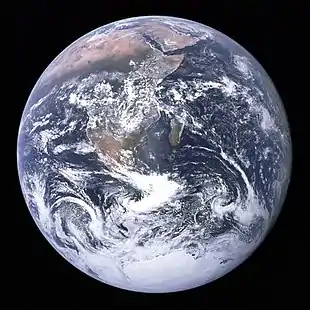Environmental studies
Environmental studies is a multidisciplinary academic field which systematically studies human interaction with the environment. Environmental studies connects principles from the physical sciences, commerce/economics, the humanities,[1] and social sciences[2] to address complex contemporary environmental issues. It is a broad field of study that includes the natural environment, the built environment, and the relationship between them. The field encompasses study in basic principles of ecology and environmental science, as well as associated subjects such as ethics, geography, anthropology, policy, education, politics, urban planning, law, economics, philosophy, sociology and social justice, planning, pollution control and natural resource management.[3] There are many Environmental Studies degree programs, including a Master's degree and a Bachelor's degree. Environmental Studies degree programs provide a wide range of skills and analytical tools needed to face the environmental issues of our world head on. Students in Environmental Studies gain the intellectual and methodological tools to understand and address the crucial environmental issues of our time and the impact of individuals, society, and the planet.
 |
| Environment |
|---|
|
|
|
History
The New York State College of Forestry at Syracuse University established a BS in environmental studies degree in the 1950s, awarding its first degree in 1956.[4] Middlebury College established the major there in 1965.[5]
The Environmental Studies Association of Canada (ESAC) was established in 1993 "to further research and teaching activities in areas related to environmental studies in Canada".[6] ESAC was officially integrated in 1994, and the first convention for ESAC was held at the Learned Societies Conference in Calgary the same year.[7] ESAC's magazine, A\J: Alternatives Journal was first published by Robert A. Paehlke on 4 July 1971.[8][9]
In 2008, The Association for Environmental Studies and Sciences (AESS) was founded as the first professional association in the interdisciplinary field of environmental studies in the United States. The AESS is also the publisher for the Journal of Environmental Studies and Sciences (JESS), which aims to allow researchers in various disciplinarians related to environmental sciences to have base for researchers to use and publish new information related to environmental studies.[10] In 2010, the National Council for Science and the Environment (NCSE) agreed to advise and support the Association. In March of 2011, The Association's scholarly journal, the Journal of Environmental Studies and Sciences (JESS), commenced publication.[11][12]
Environmental Studies in U.S. Universities
In the United States, many high school students are able to take environmental science as a college-level course.[13] Over 500 colleges and universities in the United States offer environmental studies as a degree.[14] The University of California-Berkely has awarded the most degrees in environmental studies for U.S. universities, with 409 degrees awarded in 2019. The Universities in the United States that have the highest percentage of degrees awarded is Antioch University-New England, where nearly 35% of degrees awarded in 2019 were in environmental studies.
Education
Worldwide, programs in environmental studies may be offered through colleges of liberal arts, life science, social science or agriculture. Students of environmental studies use what they learn the sciences, social sciences, and humanities to better understand environmental problems and potentially offer solutions to them. Students look at how we interact with the natural world and come up with ideas to prevent its destruction.[15]
See also
References
- Keywords for environmental studies. Adamson, Joni, 1958-, Gleason, William A., 1961-, Pellow, David N., 1969-. New York. 2016. ISBN 978-0-8147-6074-1. OCLC 933297292.
{{cite book}}: CS1 maint: others (link) - Milstein, T. & Castro-Sotomayor, J. (2020). Routledge Handbook of Ecocultural Identity. London, UK: Routledge. https://doi.org/10.4324/9781351068840
- National Center for Education Statistics. Classification of Instructional Programs (CIP 2000)- (03) NATURAL RESOURCES AND CONSERVATION Archived 12 May 2009 at the Wayback Machine. Institute of Education Sciences, United States Department of Education. [Accessed 29 January 2010]
- "About Environmental Studies at ESF," Archived 1 December 2017 at the Wayback Machine SUNY-ESF website. Accessed 28 November 2017.
- "Environmental Studies - Middlebury". middlebury.edu. Archived from the original on 5 November 2017. Retrieved 29 April 2018.
- "A Brief History of ESAC". Archived from the original on 28 January 2012. Retrieved 12 March 2012. "A Brief History of ESAC". Accessed 12 March 2012.
- "A Brief History of ESAC". ESAC. Retrieved 2 March 2022.
- Alternatives Archived 6 January 2012 at the Wayback Machine
- "The Alternatives Story" Archived 6 January 2012 at the Wayback Machine
- "AESS Publications". AESSOnline.org. Retrieved 30 April 2022.
- "Association for Environmental Studies & Sciences AESSonline.org". AESSOnline.org. Archived from the original on 10 March 2016. Retrieved 29 April 2018.
- "The History and Development of AESS". Association for Environmental Studies and Sciences. Archived from the original on 6 November 2016.
- "AP Environmental Science". Collegeboard. Retrieved 4 October 2018.
- "Major: Environmental Studies". Collegeboard. Retrieved 4 October 2018.
- "Environmental Studies College Degree Programs | The College Board". bigfuture.collegeboard.org. Retrieved 12 April 2020.
Further reading
Emmett, Rob, and Frank Zelko (eds.), “Minding the Gap: Working Across Disciplines in Environmental Studies,” RCC Perspectives 2014, no. 2. doi.org/10.5282/rcc/6313.


